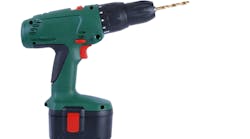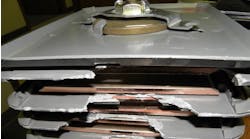© Christopher Elwell | Dreamstime.com
Battery-powered tools have had a strongly positive effect on productivity in the field. And they confer a safety advantage by eliminating tripping hazards (and, to an extent, shock hazards) from misuse of portable cords.
However, the safety advantages can be moot if the use of these tools leads to a “no dangers to even think of” mindset. Other dangers do exist. Consider these categories:
Batteries
- Industrial-grade, battery-powered tools use lithium batteries. Don’t leave them out in the sun.
- If you drop a battery while changing batteries (or drop the tool with the battery attached), stop to give it a careful visual inspection. If the case is cracked or damaged in any way, take that battery out of service.
- Don’t overcharge the batteries. While most charging systems have some form of overcharge protection, you still want to remove batteries once they are charged. Just as you don’t toss a hairdryer into an occupied bathtub and rely on the GFCI to protect the occupant, don’t rely on automatic protection to cover for sloppy charging practices.
- Don’t run a battery charger near sources of flammable vapors.
- When running the portable cord to a battery charger on a job site, follow the recommended safety procedures for portable cords (i.e., run each cord in a way that doesn’t create a tripping hazard).
Bits and blades
- If the job will involve much use of drill bits, saw blades, etc., start the job with a new bit or blade. A slip due to a dull tool might damage more than just the work surface. If there’s only a bit of such work to do, then be sure to clean the blade before using it. Dirty blades are almost as bad as dull ones.
- Use the proper bit or blade for the material being worked on.
- If the tool vibrates, makes an uneven cut, or exhibits other signs of a loose or misaligned cutting bit or blade, stop and correct the problem.
Piece under work
- Whether your tools are battery-powered or cord-connected, always secure the work with clamps or other devices. A tool can be safely handheld, the piece under work never can.
- If working with wood, consider nailing or screwing down a loose workpiece. For metal, it may be prudent to drill a bolt hole or two for the same purpose.
- If cutting wood, score the whole length of the cut mark to about 1/16th or so before using the saw. This will prevent splintering of the top layer of the wood.
- An alternative to scoring is to tape the top and bottom of the board along where you will mark the cut line. Taping is also effective for preventing splinters due to drilling if you are using the correct bit and drilling speed and pressure.
- A third trick is to clamp the wood to a sheet of foam insulation; this is something you’re likely to see in residential construction.
- When sawing wood, don’t put the cut mark between supports such that the board will sag inward toward the saw blade. This will cause the blade to bind and give you a serious injury. The typical sidewinder saw has the motor on the left and the blade on the right. You want the supports on the left so the part being cut off (on your right) falls away from the saw. In some cases, the part being cut off is too big and too heavy to not also be supported; set this up so the weight of the saw is not causing the cut line to bow downward.
- Never hold the work with your free hand; it’s a good way to lose a finger. Or two.
- Wear work gloves when handling the piece or cleaning the work area.
- Clean up scrap, shavings, etc., between each tool operation or sooner if need be.
Work methods
- Never force the tool to work with a low battery. It can easily damage the tool motor and the battery, but it’s also a way to cause a slip that causes an injury.
- Avoid binding with a saw, which can cause the workpiece to fly or the tool to break, by using a smooth motion.
- To avoid bit jumping, drill a pilot hole.
- If drilling a deep hole, drill partway and then pull the bit out to clear the hole then resume drilling.
- If driving a fastener with a drill, apply soap to the shaft before driving it in. This reduces the load on the motor, the load on your wrists, and the load on your shoulder while also reducing the chance of popping a screw into your face. Keep a bar of soap in your bit kit.
- Don’t use a Phillips bit on a square drive screw head; this can cause bits of hardened steel to fly at you.
- Always wear safety glasses when using power tools. Put them on when you pick the tool up, and take them off only when you are ready to put the tool away.
- If the work will release much dust or the wrong kind of dust, be sure to use the appropriate dust collection attachment. Along with that, wear the appropriate respirator. For example, if using a side grinder to cut a bolt or remove a stripped nut, wear a K95 or better respirator so you don’t breathe those particles into your lungs. Keep the mask on until you are done cleaning up the dust.
Sponsored Recommendations
Sponsored Recommendations
Sponsored
Sponsored




